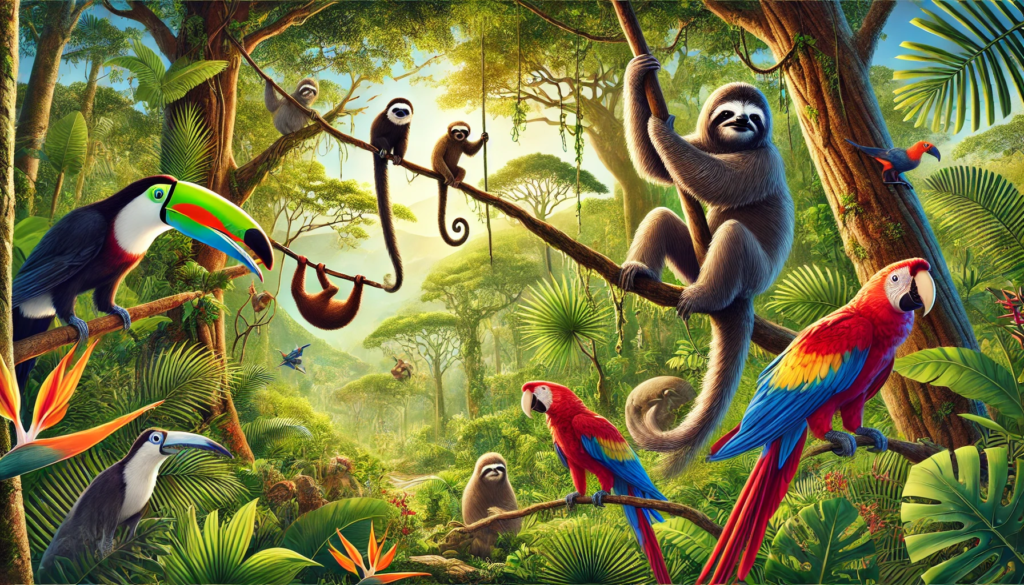The tropical rainforests of the Caribbean are home to an extraordinary variety of wildlife, forming one of the most biologically diverse regions on Earth. These lush forests, with their towering trees, dense canopies, and humid climate, provide habitats for a wide range of species, including mammals, birds, reptiles, and amphibians. Among the most iconic inhabitants are monkeys, sloths, and exotic birds, each playing a vital role in maintaining the delicate balance of these ecosystems.
This article explores the key species found in the rainforests of the Caribbean, focusing on the unique behaviors, ecological importance, and conservation status of monkeys, sloths, and exotic birds that call this vibrant environment home.
Monkeys of the Caribbean Rainforests
Monkeys are some of the most recognizable and charismatic animals in the Caribbean rainforests, known for their intelligence, agility, and social behavior. Though the Caribbean is home to relatively few native monkey species compared to other tropical regions, those that inhabit the islands are important for the health and vitality of the rainforest ecosystem.
The Red Howler Monkey (Alouatta seniculus)
One of the most iconic primates in the Caribbean region is the red howler monkey, which is native to the forests of Trinidad. These monkeys are best known for their loud, resonant calls, which can be heard over several kilometers through the dense jungle. The purpose of these vocalizations is to communicate with other groups, mark territory, and deter potential rivals.
Red howler monkeys are relatively large, with males growing up to 30 pounds. They have a primarily folivorous diet, feeding on leaves, flowers, and fruits. Their digestive systems are specially adapted to break down tough, fibrous plant material, allowing them to thrive in their arboreal environment. These monkeys play an essential role in seed dispersal, helping to regenerate the forest and maintain its biodiversity.
The Mona Monkey (Cercopithecus mona)
The mona monkey, introduced to the Caribbean island of Grenada, is not native but has established a significant population in the rainforests. Native to West Africa, the mona monkey is a small, agile primate with a striking appearance, featuring a mix of reddish-brown, white, and black fur.
Mona monkeys are highly social and live in groups of up to 20 individuals. They are omnivorous, feeding on fruits, seeds, insects, and small animals, and are often seen foraging in the treetops. Their introduction to Grenada is believed to have occurred during the transatlantic slave trade, when they were brought to the island as pets. Despite being non-native, they have adapted well to the Caribbean environment and are now a part of the region’s rainforest ecosystem.
Sloths: Masters of Slow Survival
Sloths, known for their slow movement and tranquil demeanor, are some of the most unique mammals in tropical rainforests. Although sloths are more commonly associated with Central and South America, a small population of three-toed sloths can be found in the rainforests of Trinidad.
The Three-Toed Sloth (Bradypus tridactylus)
The three-toed sloth is one of the most fascinating mammals in the rainforest, famous for its slow pace and tree-dwelling lifestyle. These sloths spend nearly their entire lives hanging upside down from tree branches, using their long claws to grip onto branches as they move through the canopy in search of leaves, their primary source of food.
One of the sloth’s most remarkable adaptations is its slow metabolism, which is perfectly suited to its low-energy diet of leaves. This slow pace also helps sloths avoid detection by predators such as jaguars, eagles, and large snakes, which rely on movement to spot their prey. Sloths are also excellent swimmers, a skill that helps them navigate the rivers and streams that run through the rainforest.
Though their numbers are small in Trinidad, sloths play a crucial role in the rainforest ecosystem by contributing to nutrient cycling and seed dispersal.
Exotic Birds of the Caribbean Rainforests
Perhaps the most colorful and diverse group of animals in the Caribbean rainforests are the birds. With their brilliant plumage and melodious calls, birds are essential for pollination, seed dispersal, and controlling insect populations. The rainforests of the Caribbean are home to many species of parrots, toucans, and hummingbirds, among others, each contributing to the vibrant soundscape and visual beauty of the jungle.
The Cuban Trogon (Priotelus temnurus)
The Cuban trogon, also known as the tocororo, is Cuba’s national bird and a symbol of the island’s natural beauty. This stunning bird has bright green, white, and red plumage that mirrors the colors of the Cuban flag. The Cuban trogon is a fruit-eating bird that lives in the forest canopy, where it forages for berries, insects, and small invertebrates.
Unlike many birds in the Caribbean, the trogon is monogamous and mates for life, often seen nesting in hollow trees. Its melodious call can be heard echoing through the rainforest, making it one of the most distinctive voices in the jungle. The Cuban trogon is also an important pollinator and seed disperser, aiding in the regeneration of forest plants.
The Puerto Rican Amazon Parrot (Amazona vittata)
The Puerto Rican amazon parrot is one of the most critically endangered birds in the Caribbean, native to the island’s El Yunque rainforest. This bright green parrot, with a vivid blue flight feathers and a striking red forehead, once flourished in the forests of Puerto Rico, but deforestation and hunting have reduced its population to dangerously low numbers.
Conservation efforts are underway to protect the remaining populations of this rare parrot, including captive breeding programs and habitat restoration projects. Despite its critically endangered status, the Puerto Rican amazon remains a symbol of the island’s natural heritage, and efforts to conserve it continue to offer hope for its survival.
The Keel-Billed Toucan (Ramphastos sulfuratus)
The keel-billed toucan is one of the most recognizable and charismatic birds of the Caribbean rainforests, with its large, brightly colored beak and striking black and yellow plumage. Found primarily in the forests of Belize and parts of Central America, this toucan is an omnivorous species that feeds on fruits, insects, eggs, and small vertebrates.
The toucan’s massive bill, which can be up to one-third of its body length, helps it reach fruit from branches that are too small to support its weight. The bill is also used for defense against predators and to regulate body temperature. Keel-billed toucans are social birds, often found in small flocks, and their loud, frog-like croaks can be heard throughout the forest.
Hummingbirds
Hummingbirds are one of the most enchanting sights in the Caribbean rainforests, with their iridescent feathers and rapid wingbeats. These tiny birds are incredibly agile fliers, capable of hovering in place as they feed on nectar from flowers. The Caribbean is home to several species of hummingbirds, each playing a critical role in pollination.
The Antillean Crested Hummingbird (Orthorhyncus cristatus)
The Antillean crested hummingbird is a small but dazzling bird found in the Lesser Antilles, including islands such as Saint Lucia, Martinique, and Dominica. It is easily recognized by the bright green or blue crest on the males, which they use to attract mates. Hummingbirds like this species are essential pollinators for many tropical plants, transferring pollen between flowers as they feed on nectar.
Conservation of Caribbean Rainforest Wildlife
The wildlife of the Caribbean rainforests is under increasing threat from deforestation, habitat loss, and climate change. Many species, such as the Puerto Rican amazon parrot and the three-toed sloth, are now endangered or critically endangered due to human activities that destroy their natural habitats.
Habitat Protection and Restoration
Protecting and restoring the rainforests of the Caribbean is crucial for the survival of the species that depend on them. National parks, wildlife refuges, and protected areas, such as El Yunque National Forest in Puerto Rico and Guanica Dry Forest in the Dominican Republic, offer safe havens for many threatened species. Reforestation projects and conservation programs aim to restore degraded areas, ensuring that future generations of wildlife have a place to thrive.
Ecotourism and Community Involvement
Ecotourism plays an important role in the conservation of the Caribbean’s rainforests by providing economic incentives to protect these environments. Visitors from around the world are drawn to the region to experience its wildlife and natural beauty, contributing to local economies and supporting conservation efforts. Community involvement is also essential, as local people often serve as stewards of the land, guiding sustainable tourism practices and participating in reforestation projects.
Conclusion
The tropical rainforests of the Caribbean are home to an astonishing diversity of life, from the agile monkeys and tranquil sloths to the colorful parrots and vibrant hummingbirds. These species are not only iconic representatives of the Caribbean’s natural beauty but also play essential roles in maintaining the health and balance of their ecosystems.
However, many of these species are now at risk due to habitat loss, deforestation, and climate change. By continuing to protect these rainforests and supporting conservation initiatives, we can help ensure that the wildlife of the Caribbean continues to thrive for generations to come.
FAQ
What are the most common monkey species found in Caribbean rainforests?
The red howler monkey of Trinidad and the mona monkey of Grenada are two notable primates in the Caribbean. The red howler is known for its loud vocalizations, while the mona monkey was introduced to the region but has adapted well to its new environment.
Are sloths found in the Caribbean?
Yes, the three-toed sloth can be found in the rainforests of Trinidad. While sloths are more common in Central and South America, Trinidad’s rainforest is home to a small population of these slow-moving mammals.
What is the most endangered bird in the Caribbean rainforests?
The Puerto Rican amazon parrot is one of the most critically endangered birds in the Caribbean, with conservation efforts focused on restoring its population in Puerto Rico’s El Yunque rainforest.
How do hummingbirds contribute to Caribbean rainforest ecosystems?
Hummingbirds, such as the Antillean crested hummingbird, are essential pollinators in the Caribbean rainforests. Their role in transferring pollen between flowers helps maintain the diversity of plant species in the region.
What threats do Caribbean rainforest species face?
Caribbean rainforest species face significant threats from deforestation, habitat loss, and climate change. Many species are also endangered due to hunting, illegal wildlife trade, and the destruction of their natural habitats.
How can we help protect Caribbean rainforest wildlife?
Supporting conservation efforts, promoting ecotourism, and protecting national parks and wildlife refuges are key ways to help safeguard the species of the Caribbean rainforests. Community involvement and education are also essential in fostering sustainable practices.

